Ashley Parkinson is coordinator of Seattle Audubon Society’s Northwest Shade Coffee Campaign, which works to educate retailers and consumers about the benefits of shade-grown coffee.

Monday, 7 Jan 2002
SEATTLE, Wash.
Trust me, if you stand on any street corner in downtown Seattle and turn in a circle, you’ll see no less than four coffee shops — and two of them will probably be Starbucks. Although the notoriously bad Seattle weather could contribute to a culture of caffeine addicts, the phenomenon is hardly unique to the Northwest. From tall double decaf soy lattes to instant Sanka, Americans drink more than 400 million cups of joe per day, or one-third of global consumption. Our predilection makes coffee the second most widely traded commodity on the world market after oil.
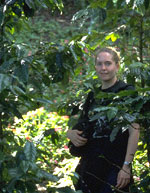
Me in the coffee trees.
Photo: Bill Bradlee, Seattle Audubon Society.
Yet despite our booming coffee culture, most Americans will never see a coffee tree, because production is concentrated in the warm climates of the developing world. We are familiar with the dark brown, already-roasted beans, not the unhusked green beans or the red berries clinging to waist-high bushes in Central and South America, Vietnam, and Africa.
American consumers mark the end of a long chain of farmers, importers, roasters, and distributors — 20 million worldwide — that make a living from coffee. Advertising departments might bill it as “the best part of waking up,” but the coffee you drink has serious social and environmental implications half a world away. My job as coordinator of the Northwest Shade Coffee Campaign is to get people to understand those implications by familiarizing them with the lengthy chain of events connecting people to coffee, and connecting coffee to the birds that sing outside your window while you drink your morning cup.
The majority of neotropical birds in the Pacific Northwest (and 60 to 80 percent of the birds in eastern U.S. forests and Canada) winter in the mid-elevation forests of Latin America. Many of these forests have been cleared and converted to permanent cropland, and modern, high-tech coffee production is hastening that process. Traditionally, coffee is planted on small farms under the forest canopy, where farmers often grow fruit trees or other supplementary crops alongside the coffee bushes. The flowers and fruits of the shade trees attract omnivorous species like MacGillvray’s Warbler and Orchard Orioles by providing food and protection from predators. Researchers have found a surprising biodiversity of birds, bats, butterflies, ants, amphibians, and orchids in shade coffee plantations.
Under the guidance of international development agencies, including USAID, this pattern began to change in the 1970s, as farmers converted their shade coffee crops to full sun. Coffee yields increase substantially on sun plantations, but the increase comes at a price: The plants need far more chemical inputs — particularly nitrogen fertilizers — and the monocultures increase soil erosion and water pollution. Converting to full sun coffee farming not only destroys habitat for birds, but also reduces options for farmers who are completely dependent on the international price of coffee. Small farmers rely on secondary crops from shade coffee plantations like fruit and wood to help them survive increasingly harsh market conditions. Lately, those conditions have become all but unbearable, as world coffee prices have fallen to all-time lows because of increased production of low-grade beans in Vietnam and other countries. You may be paying $12 for a pound of beans, but the farmers are getting around 50 cents or less for selling the same quantity.
At these prices, small family farms can’t break even. As a result, traditional shade coffee farmers are forced to abandon or sell their farms and more land is being converted to sun plantations. The U.N. World Food Program estimates that 150,000 people have become refugees because of the recent coffee crisis. In an ironic twist, some coffee farmers in Columbia are switching their crops to a different, more valuable commodity (although one that is rarely counted on world markets): coca, the key ingredient in cocaine.
The Northwest Shade Coffee Campaign is one of several organizations in the U.S. trying to influence coffee drinkers to choose sustainably grown coffee. Fair trade, shade-grown, organic coffee is quite a mouthful to ask for when you’re barely awake, which is one of the reasons our campaign focuses on educating retailers as well as consumers. Still, it’s an uphill fight. We concentrate our efforts on the specialty coffee market (those beans sold at high-end stores like Starbucks), but that market represents only about 15 per cent of total coffee consumption.
As I drink my own cup of certified shade-grown coffee, the numbers seem overwhelming:
- 20 million people employed in the coffee trade
- 46 cents per pound on the world market
- Half as many birds migrating to and from North America than in the 1960s
- 90 percent fewer bird species found on sun coffee farms than on shade farms
Fired up both literally and figuratively by coffee, I pick up the phone and get to work.
Tuesday, 8 Jan 2002
SEATTLE, Wash.
It seems like two weeks of holiday vacation is prompting a backlash; my schedule book has filled up quickly. Seattle Audubon is one of seven organizations funded by the same foundation to promote shade-grown coffee, and in the last few months, the various groups have been keeping in close contact. Meeting with campaign partners and keeping up on the minutia of the coffee trade takes more time than I often care to admit.
Fortunately, I also spend a lot of time talking to the public — college students, other activists, supermarket shoppers — about songbirds and coffee. In my slide presentations, I try to explain the impact coffee has on the environment in Latin America, a process I recently got to witness firsthand.
Last July, I spent a month in Nicaragua and Costa Rica visiting shade coffee farms, talking to farmers, and taking pictures. Flying in, the airplane-eye view of the deep green mountains of Central America was incredible. Once on the ground in Nicaragua, however, the reality of life in one of the poorest nations in the Western hemisphere was as oppressive as the blanket of humidity that hangs over the capitol city of Managua. Three years ago, Hurricane Mitch dumped a couple of feet of rain on the already-struggling country, killing thousands, washing away tons of topsoil, and further impoverishing small farmers. Now the recent drop in world coffee prices has made the economic situation even worse. Things have gotten so bad, a taxi driver told me, that people were fleeing to the U.S. because they could no longer make a living farming. In other words, people would rather risk dying in the desert than stay in Nicaragua.
Up in the mountains of Nicaragua, the temperature cooled off and it was easier to imagine a more promising future for the nation’s farmers. One of my first stops was Selva Negra, a sustainable coffee plantation that produces shade-grown coffee and other agricultural products and welcomes tourists. Meaning “black forest,” Selva Negra was established by descendents of the original German settlers who introduced coffee farming to Nicaragua a century ago. Touring the plantation, I could hear the screeching of howler monkeys in the near-pristine forest and see toucans perched on the railings of outbuildings.
At Selva Negra, coffee is grown under a modified shade canopy, meaning that the forest is actively managed to allow enough sunlight for the plants. It’s a labor-intensive process, but it produces some of the highest-quality beans in Nicaragua. The entire plantation is designed to mimic natural systems and reduce pollution. Selva Negra produces its own fertilizer from the pulp of the coffee cherry and uses captured methane gas from the decomposition of other wastes to power cooking stoves, nearly eliminating the need for wood as a fuel source.
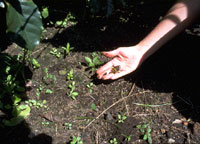
Crumbly soil on a sun coffee plantation.
Photo: Bill Bradlee, Seattle Audubon Society.
Down the road, however, a sun plantation demonstrated the stark contrast between the two styles of coffee farming. The farmers there told me the people at Selva Negra were crazy. The number of plants per acre increases nearly three-fold under full sun, they said. But when I reached down, the soil was dry, not at all like the moist compost at Selva Negra. There were virtually no birds. Without the overstory and the fauna that live there, insects are a constant problem. This plantation was hardly sustainable; without fertilizers and pesticides, the plants would die. And in Central America, pesticides are applied with less regulation and less regard for worker safety than in the U.S. As late as 1990, Costa Rica permitted the use of chlordane, a highly persistent insecticide banned in the United States.
The workers on the sun plantation couldn’t understand why anyone would give up the yields made possible by full-sun farming. But they also didn’t understand that they’d painted themselves into a corner. Dependent on expensive chemicals, they would have difficulty weathering the steep drop in coffee prices.
Back in the U.S., when I tell people about my trip and show them the slides, they start to get it. After the presentation, they can visualize the worker who picked the 100 beans that went into their cup of coffee. And they can see how their choice of which kind of coffee to drink affects the future of developing countries like Nicaragua.
Wednesday, 9 Jan 2002
SEATTLE, Wash.
Today I’m trying to schedule a meeting with a local coffee importer to tour their operation and learn more about their perspective on the coffee business. It’s a visit that’s probably long overdue, but somehow I’ve managed to put it off. Importers represent just one step in the process of converting coffee from crop to steaming cup, but they’re crucial to establishing shade-grown varieties in the specialty market. What they choose to market to roasters and retailers is what ends up in the cafes and stores. Some promote shade-grown organic beans; others don’t.
When the Northwest Shade Coffee Campaign began six years ago with a group of volunteers and the support of several local coffee companies, we approached the coffee issue much the same way activists tackle any problem: We held events and raised money and waited for change to come. And it did. Today, 45 roasters and retailers are part of the campaign. Each has pledged to offer at least one line of shade-grown coffee year-round and educate their customers about the benefits of shade-grown coffee. In exchange, they get to use our logo on their products.
To achieve what we have in the last six years, we’ve had to learn a lot about the business of coffee. For instance, something as basic as shade certification (independent confirmation that coffee is actually grown under shade conditions) is expensive and difficult to obtain. The sheer number of farmers, the different farming methods, and the vast geographic area all inhibit our information-gathering. Both the Smithsonian Migratory Bird Center and the Rainforest Alliance certify shade-grown coffee, but there is no universal standard, no single label that lets consumers know they are buying coffee that is shade-grown.
We took a big step forward last May, when the Consumer’s Choice Council issued “Conservation Principles for Coffee Production,” a set of guidelines that can be used to create certification systems. The principles advocate coffee farming that protects wildlife and habitat, conserves water and energy, and creates sustainable jobs. These principles have been a powerful tool; Starbucks has used them to change their sourcing practices, prioritizing environmentally and socially responsible coffee in their acquisition process.
For now, though, consumers wade through three different systems when buying socially responsible coffee. In addition to shade-grown coffee, fair trade and organic coffee command attention on the supermarket shelves. Certified fair-trade importers like Equal Exchange work directly with coffee cooperatives, ensuring that farmers receive a stable price of $1.26 per pound. While U.S. importers encourage their cooperatives to adopt organic and shade practices, fair trade coffee is not necessarily organic or shade-grown. The best estimates are that 70 percent of fair trade coffee is organically produced.
If socially and environmentally responsible coffee is ever to move beyond the niche market of specialty coffee and “into the can,” we’ll need to develop one consistent label that indicates triple-certification. Three companies — Folgers, Nestle, and Kraft — control much of the mainstream coffee market. To date, they have done almost nothing to determine the source of their beans. Working through brokers and combining coffee from different countries to create their signature roasts, the big three conveniently opt to look the other way when it comes to the health of the workers and of the environment in coffee-producing countries.
I think that can change. But like the “dolphin-safe tuna” campaign of the 1980s, coffee will need an instantly identifiable logo to communicate to the majority of Americans who can’t tell the difference between a cappuccino and a latte. Right now we’re applying for funding to work with other organizations, like Conservation International, on the ground in coffee country, but a coordinated effort to ensure a steady supply of certified shade-grown coffee is still a couple years off.
Sometimes my ambitions for this project start spinning out of control. I’m so excited for everything to work, but I need to concentrate on building on what we’ve already accomplished — like working on all fronts with consumers, importers, and retailers. Which reminds me, I’ve got a meeting to schedule.
Thursday, 10 Jan 2002
SEATTLE, Wash.
There’s a chance of rain this morning, but in western Washington in January, that doesn’t come as much of a surprise. Despite the forecast, I’ve decided to do a little pre-work birding on Spencer Island, a small landmass about 30 miles north of Seattle formed by the rivers leading to Puget Sound. A low, wet estuary ecosystem, it’s ideal for spotting birds. I like to get there just before sunrise, when there is the most activity, even though it means getting up around 6 a.m.
This early in the morning, all the traffic on the freeway is heading south into Seattle and I count myself lucky that I don’t live out in the northern suburbs. As I drive, I can alternately see the Olympics to the west and the Cascades to the east just below a line of thick, purple clouds. When I arrive at the island, a couple of cars in the parking lot signal that I’m not alone, which is great because (believe it or not) birding is a very social activity. We share information, gossiping about who has seen what.
Someone tells me excitedly that there are redpolls mixed in with a flock of pine siskins on the south side of the island — typical birder talk. I find the redpolls and check them off my “life list.” I am not a hardcore birder with a typed life list in hand at all times, but there’s a certain thrill in mentally noting a new species.
Winter is an ideal time for birding in the Northwest, even if our migrants have flown south. Walking around the island, I see a big flock of tundra swans and a great blue heron. A couple of northern harriers hunt for prey on the ground while I listen to a downy woodpecker banging its head against a tree. I pass by a tree full of bright red-headed ruby-crowned kinglets and scare a lone American bittern out of a marsh. After an hour or so on the island, activity slows down.
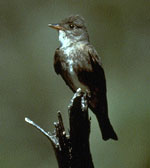
An olive-sided fly catcher.
Photo: Seattle Audubon Society.
As I head back to my car, it strikes me that it won’t be long — just a few more months — before songbirds start returning to Washington. Migratory birds are amazing creatures. Weighing as little as one ounce, you could mail many of them with a single postage stamp, yet some travel thousands of miles each year. Take the olive-sided flycatcher, for example. A long-distance migratory bird, it travels from as far north as Alaska in the summer to the forests of the northern and central Andes in the winter. But populations have declined by about 25 percent since the 1960s, primarily due to habitat loss. Andean valleys are almost completely deforested, and 85 percent or more of montane forests have been cut. In the U.S., the olive-sided flycatcher prefers mature, coniferous forests, particularly those undergoing natural fire disturbance regimes. The decline in old growth forests and national fire suppression policies have seriously fragmented remaining habitat.
In North America, we’ve had 30 years or more of environmental awareness and still habitat loss occurs at an alarming rate — suburbs creep into the mountains and pollution from lights increases, throwing birds off course. Pesticides, though not nearly the problem they were in the 1960s, still run off suburban lawns and agricultural fields, profoundly affecting small creatures like songbirds.
Despite all this, birding is an exhilarating way to begin the day. Driving back to Seattle, back to my office and the computer and phone, I know that I need to go out bird-watching more often. And I can’t wait to see that first flycatcher or vireo, back from a long flight and a warm winter in coffee country.
Friday, 11 Jan 2002
SEATTLE, Wash.
Today I’ve got a big conference call scheduled with our campaign partners. Even though we haven’t yet received a grant we applied for jointly, we’re beginning to plan a campaign involving some of the country’s largest specialty coffee retailers to increase sales of shade coffee. You would probably recognize the companies — some have stores across the country — but I guarantee you that the campaign is less glamorous that you’re thinking. Stop picturing rowdy protesters chanting “No more bird blood for lattes!” outside the local Starbucks. Think business plans and supplier agreements, certification criteria and educational brochures.
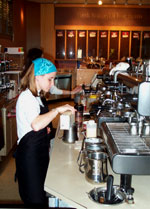
Organic caffeinated goodness at Caffe Appassionato.
Photo: Seattle Audubon Society.
It may be less sexy, but it’s what will work in the end. Putting pressure on one company is a sure way to make all of them mistrust us. We’ve found that building relationships, making the process as easy as possible, and providing convincing evidence based on past results is what matters. It’s this low-key persistence that allowed us to announce this spring the opening of an all-organic Caffe Appassionato store, a local coffee roaster and retailer. In the end, most of the coffee companies we’re working with — whether they are national or regional — have progressive roots and progressive customers; they want to do the right thing.
And it’s the same with individual coffee drinkers. My evidence is anecdotal, but the response at our events is always positive. The problem is getting the word out. We can’t run a TV commercial during prime time or put a billboard on every corner, but there are other ways to get attention. One of Seattle’s recent high-profile events was a concert last spring sponsored by our coalition partner, the Songbird Foundation, that featured Danny O’Keefe, Bonnie Raitt, Jackson Browne, and Keb’Mo’.
Usually, though, I concentrate on small events staffed by our volunteers. Right now, I’m mobilizing the troops to run a booth at the Environmental Expo, part of the Seattle Home Show. We plan to have a coffee tasting, and, of course, literature available at the table. One of the big selling points with shade coffee is that the flavor is typically sweeter and less bitter than coffee made from quick-growing sun beans. For most people, the choice of coffee is determined more by quality, taste, health, and convenience than the environment. So we talk up the flavor, the organic growing conditions, and the high quality. I don’t mind modifying our message to meet the consumer, so long as the point is taken.
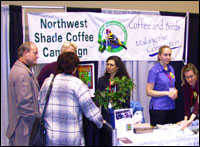
Coffee-talking volunteers.
Photo: Seattle Audubon Society.
One the most innovative ideas for spreading the word about shade-grown coffee (and I wish I’d thought of it), is enlisting churches. Think about it: What do people do after church? They drink coffee and talk. Shade-grown, fair-trade coffee is consistent with the social and environmental goals many ministries already support, and churches offer a powerful vehicle for educating a diverse and committed audience. If we sign on enough congregations, the word will begin to spread within the religious community, we’ll gain another campaign ally, and we’ll reach people who would not usually hear our message.
Our volunteers also attend birding festivals, warming cold hands with warm cups of coffee and talking about the winter habitat of songbirds. And in the future, the campaign will work with Northwest colleges and universities to sign agreements to sell shade-grown coffee in campus snack-bars and dining halls. As for what’s next, since the Northwest Shade Coffee Campaign has a staff of one (me), I’m willing to try anything that will work.

I got interested in avian ecology during a college internship with the International Bird Rescue and Rehabilitation Center in California. As I worked with the vets and rehabbers, I saw first hand the problems — many of them caused by humans — facing birds in North America. I know that, unlike me, most people will never see these problems first hand; most will never travel to the coffee farms of Latin America, just as most of us will never see the Arctic National Wildlife Refuge. Hopefully, we choose to protect these areas anyway, because of our values and personal commitment, our appreciation for the natural world, and our recognition of the importance of living sustainably on the Earth. On the scale of environmental commitment, drinking shade-grown coffee is pretty easy, but it changes the world — one cup at a time.
You can find a list of outlets that sell shade-grown coffee in the Northwest on our website. National lists of certified shade-grown coffee are at the Smithsonian Migratory Bird Center website and the Rainforest Alliance website.

